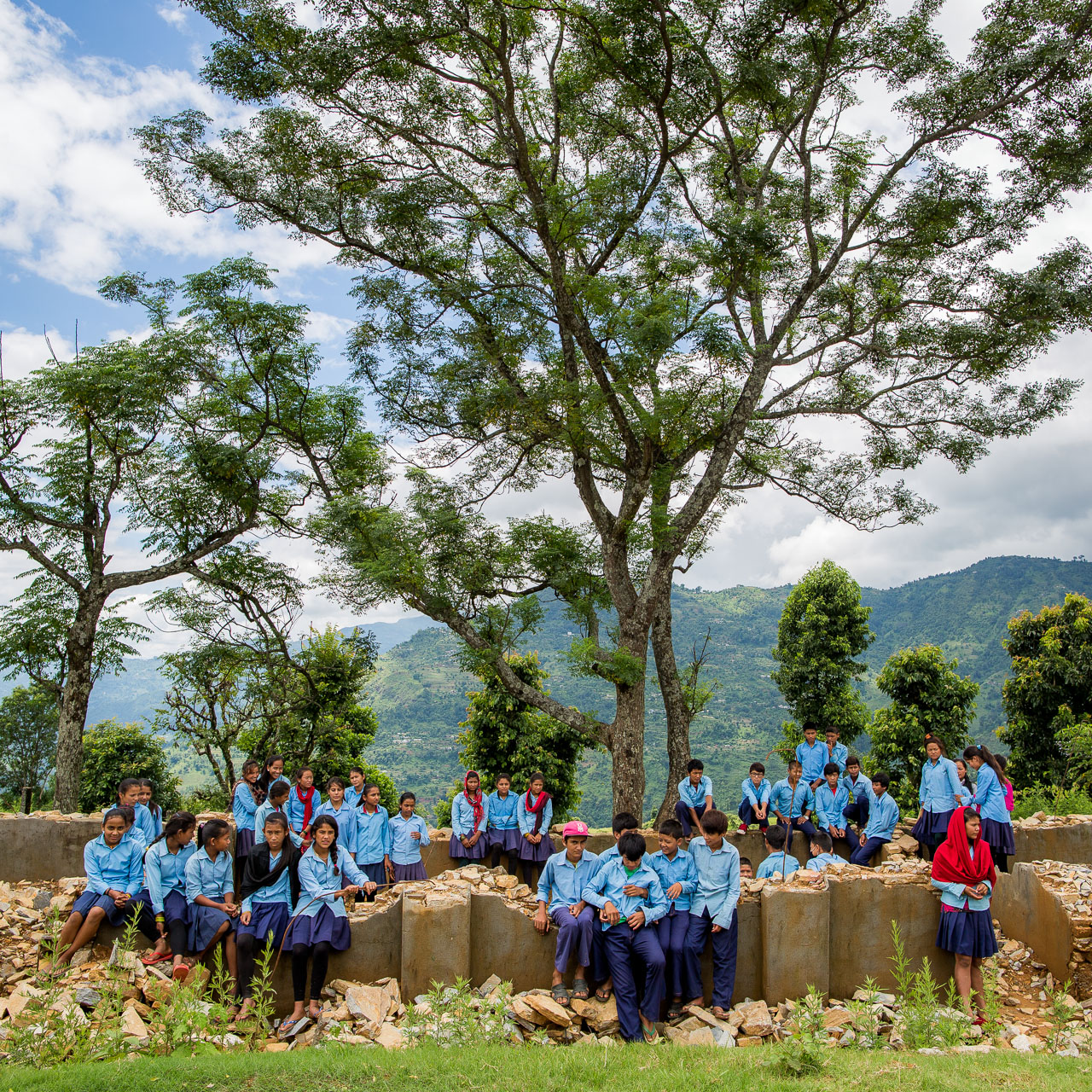All the students amongst the ruins of their school.
Climb from Baluwa to Simjung
I had met Pranjali Gurung the previous day and she introduced me to her brother who was the Village Secretary of Baluwa and had been hired as a social worker by Oxfam. Hewas going up to Simjung the next morning to handover some health promotion posters. I decided to join him because I wanted to see for myself the damage caused by the earthquake and how the people were coping with the aftermath.
Students in their temporary tent classrooms donated by the Indian Army.
Social worker for Oxam who wanted to guide me to Simjung.
I was told most NGOs hadn’t visited Simjung as they all were going to the bigger and more easily accessible village of Barpak.
The day before I had met a few teachers from the Shree Himalaya Higher Secondary School in Simjung. They told me that they only had temporary school buildings and that there was no funding available to pay permanent buildings for school. I was invited to visit their school and hear their story.
Girl on her way to school, cooling herself with her scarf. She was the daughter of the family with whom I stayed in Baluwa.
Teacher leading the morning school Assembly.
It was a long and extremely hot 600 metre climb up to the village of Simjung. I wasn't thinking about myself but these children that were joining us in the walk up. They had to walk one and a half hours up to school and later one hour all the way back down to their homes, six days a week. As schools in Nepal start at ten o'clock, they had to start walking at half past eight. Sunrise at this time of the year is around five o'clock and by nine o’clock the temperature has already reached thirty five degrees. All the children were using umbrellas to try to shield themselves from the burning sun. We stopped 3 time in the shade to recover. They had were laughing and giggling but unfortunately it was hard for me to understand.
Children exercising at their morning assembly.
Arriving at school in the morning I observed their morning assembly. The English teacher explained what was happening and after the assembly guided me around the ruins of the old school.
Lined up from youngest to oldest. The school day begins like this every morning, in every school across Nepal.
The principal of the Shree Himalaya Higher Secondary School standing amongst all that remains of their once beautiful school building.
INTERVIEW AT THE HIGHER SECONDARY SCHOOL IN SIMJUNG.
Students showing me the remains of their school benches. They are hoping for funding so they can buy material to repair them.
All the school’s buildings were destroyed. In total 19 classrooms were lost. The Nepali government has given 3 lakh (300 000) rupees (about € 2750).This money was only enough to build 10 temporary classrooms out of tin. The rest of the classes are still given in 10 tents donated by the Indian Army. A German man named Gunther gave school teaching materials including whiteboards, a globe and pencils.
Photo taken from the outside of the school window of the 8th class. School windows in Nepal are always covered by bars.
The tin buildings get extremely hot in the strong summer sun. Temperatures rise to above 35 degrees in the classrooms and there is no ventilation besides a few windows. The English teacher explained to me that after a few months the cold winter season will start. Temperatures here in this mountain area will drop to between 5 and 10 degrees. The thin buildings will not give sufficient shelter against the strong cold winds. Because of this the teacher asked for support for the village school. The Nepali government will not provide more help at this time and it is very uncertain whether it will provide any further help in the future.
Third class with their teacher.
Extra lessons given to three 11th Class students.
The babies of the school - 2nd Class.
I was told the villagers were lucky because the earthquake came on Saturday which is a holiday. All the teachers lost their homes and some had family members injured. After the earthquake their first priorities had been to take care of their families, find and arrange food and build temporary shelters.
Boys from 6th class.
Namaste: The traditional gesture of greeting with hands held together and raised in respect.
Girls reading from their books.
Three days after the earthquake all teachers gathered together and went to see what the earthquake had done to their school. They found a disaster. The buildings had collapsed. Gone were the desks, chairs, computers, whiteboards, books, and posters. The solar panels which provided enough power for small lights in classrooms had been smashed.
Seventh class.
Secondary level English teacher with the girls from his class. Boys and girls are taught separately in all governmentschools.
Teaching 5th Class in one of the tents donated by the Indian Army.
The remains of the school’s computers. Now they have to try and teach without them.
In the staff tent the teachers were eating biscuits that were provided by the wfp.org NGO.
The teachers wrote a letter for me to ask for help. I will try to publish it in the Netherlands. It became clear to me that Simjing has missed out on assistance with most of the aid going to Barpak and Laprak because they are accessible by road.
Principal, teacher and his class in their tent donated by the Indian Army.
During lunch break I asked the students to gather on the ruins of their old school building for a group photo. The first photo is just two classes together in their old classrooms. Following to this all 400 students gathered at the remains of their school (see first photo of this post).
Children from three classes in the ruins of their classrooms.
Children in the remains of their classrooms.
Girl standing in front of her temporary tin classroom.
Girl posing in front of her classroom. The school benches in the background, twisted by the destructive force of the earthquake, are in need of some maintenance.
Most of the children at the school are and happy that they can go to school again as their education was interrupted for two months after the earthquake.
All that remains of the school’s precious stock of text books
After visiting the school with them we walked further through the village of Simjung. Buddhist prayer flags were flapping in the breeze. But where before a little Buddhist temple stood there was now only a pile of stones and the broken top of the temple. I looked around the place and found many ruined textbooks and student’s exercise books.
Students arriving home in their village.
Child passing all that remains of her house every morning going to school and every afternoon returning home. The look on her face shows her feelings…































